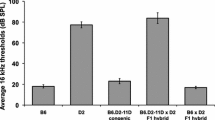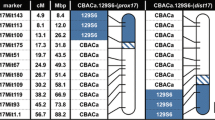Abstract
Although recent progress in identifying genes involved in deafness has been remarkable, the genetic basis of progressive hearing loss (or age-related hearing loss) is poorly understood because of the extreme difficulty in studying such a late-onset, complex disease in human populations. Several inbred strains of mice such as 129P1/ReJ, C57BL/6J, DBA/2J, and BALB/cByJ have been reported to exhibit age-related hearing loss and provide valuable models for human nonsyndromic progressive deafness. In this article we show that 101/H mice also exhibit progressive deafness with early onset. Linkage analysis of F2 populations derived from crosses between the 101/H and the MAI/Pas and MBT/Pas wild-derived mice suggested at least two major quantitative trait loci (QTLs) that influence progressive hearing loss. A first QTL, designated Phl1, was mapped with a maximum LOD score of 6.7 to the centromeric region of Chromosome 17, where no deafness-related QTL has been mapped so far. A second QTL, designated Phl2, mapped to Chromosome 10 and exhibited a maximum LOD score of 5.3. The map position of Phl2 near the well-known QTL of age-related hearing loss (Ahl) suggested the possibility of allelism, although the Ahl mutation itself did not segregate in these crosses. Finally, we found some evidence of epistatic interaction between Phl1 and Phl2.







Similar content being viewed by others
References
Ansar M, Ramzan M, Pham TL, Yan K, Jamal SM, et al. (2003) Localization of a novel autosomal recessive non-syndromic hearing impairment locus (DFNB38) to 6q26–q27 in a consanguinous kindred from Pakistan. Hum Hered 55: 71–74
Davis A, Wood S, Healy R, Webb H, Rowe S (1995) Risk factors for hearing disorders: epidemiologic evidence of change over time in the UK. J Am Acad Audiol 6: 365–370
Di Palma F, Holme RH, Bryda EC, Belyantseva IA, Pellegrino R, et al. (2001) Mutations in Cdh23, encoding a new type of cadherin, cause stereocilia disorganization in waltzer, the mouse model for Usher syndrome type 1D. Nat Genet 27: 103–107
Doan DE, Erulkar JS, Saunders JC (1996) Functional changes in the aging mouse middle ear. Hear Res 97: 174–177
Fortnum HM, Summerfield AQ, Marshall DH, Davis AC, Bamford JM (2001) Prevalence of permanent childhood hearing impairment in the United Kingdom and implications for universal neonatal hearing screening: questionnaire based ascertainment study. BMJ 323: 536–540
Hequembourg S, Liberman MC (2001) Spiral ligament pathology: a major aspect of age-related cochlear degeneration in C57BL/6 mice. J Assoc Res Otolaryngol 2: 118–129
Hunter-Duvar IM (1978) A technique for preparation of cochlear specimens for assessment with the scanning electron microscope. Acta Otolaryngol Suppl 351: 3–23
Johnson KR, Zheng QY, Erway LC (2000) A major gene affecting age-related hearing loss is common to at least ten inbred strains of mice. Genomics 70: 171–180
Martin P, Swanson GJ (1993) Descriptive and experimental analysis of the epithelial remodellings that control semicircular canal formation in the developing mouse inner ear. Dev Biol 159: 549–558
Noben-Trauth K, Zheng QY, Johnson KR (2003) Association of cadherin 23 with polygenic inheritance and genetic modification of sensorineural hearing loss. Nat Genet 35: 21–23
Ohlemiller KK (2004) Age-related hearing loss: the status of Schuknecht’s typology. Curr Opin Otolaryngol Head Neck Surg 12: 439–443
Ohlemiller KK, Gagnon PM (2004) Cellular correlates of progressive hearing loss in 129S6/SvEv mice. J Comp Neurol 469: 377–390
Parkinson N, Brown SD (2002) Focusing on the genetics of hearing: you ain’t heard nothin’ yet. Genome Biol 3; COMMENT2006
Petit C, Levilliers J, Hardelin JP (2001) Molecular genetics of hearing loss. Annu Rev Genet 35: 589–646
Rosowski JJ, Brinsko KM, Tempel BI, Kujawa SG (2003) The aging of the middle ear in 129S6/SvEvTac and CBA/CaJ mice: measurements of umbo velocity, hearing function, and the incidence of pathology. J Assoc Res Otolaryngol 4: 371–383
Siemens J, Lillo C, Dumont RA, Reynolds A, Williams DS, et al. (2004) Cadherin 23 is a component of the tip link in hair-cell stereocilia. Nature 428: 950–955
Steel KP, Kros CJ (2001) A genetic approach to understanding auditory function. Nat Genet 27: 143–149
Steel KP, Smith RJ (1992) Normal hearing in Splotch (Sp/+), the mouse homologue of Waardenburg syndrome type 1. Nat Genet 2: 75–79
Witmer PD, Doheny KF, Adams MK, Boehm CD, Dizon JS, et al. (2003) The development of a highly informative mouse Simple Sequence Length Polymorphism (SSLP) marker set and construction of a mouse family tree using parsimony analysis. Genome Res 13: 485–491
Zheng QY, Johnson KR, Erway LC (1999) Assessment of hearing in 80 inbred strains of mice by ABR threshold analyses. Hear Res 130: 94–107
Acknowledgments
The authors thank Dr. Bruce Cattanach for pointing out the hearing loss in 101/H mice. This work was supported by the MRC, Wellcome Trust, Deafness Research UK, and the EC (CT97-2715 and QLG2-CT-1999-00988).
Author information
Authors and Affiliations
Corresponding author
Additional information
Tomoji Mashimo, Alexandra E. Erven, and Sarah L. Spiden contributed equally to this work.
Electronic Supplementary Material
Rights and permissions
About this article
Cite this article
Mashimo, T., Erven, A.E., Spiden, S.L. et al. Two quantitative trait loci affecting progressive hearing loss in 101/H mice. Mamm Genome 17, 841–850 (2006). https://doi.org/10.1007/s00335-004-2438-5
Received:
Accepted:
Published:
Issue Date:
DOI: https://doi.org/10.1007/s00335-004-2438-5




